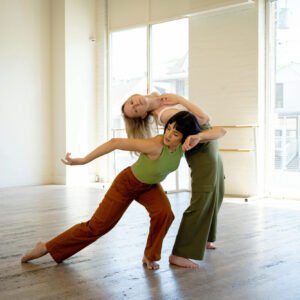Introduction
Music and Movement is a dynamic and expressive practice that combines rhythmic sounds with physical motion to promote emotional release, social connection, and stress relief. This method harnesses the power of music’s rhythm and melody, paired with intentional or freeform movements, to create a holistic and interactive experience.
Whether practiced individually or in groups, music and movement encourage participants to explore their emotions, connect with others, and enjoy a playful yet meaningful form of self-expression. This practice is accessible to people of all abilities, making it an inclusive way to improve relationships, enhance sociability, and alleviate stress.

Benefits
-
Strengthens Emotional Bonds
Shared musical and physical activities foster trust and emotional connection. Moving together to a rhythm or song creates a sense of harmony and strengthens interpersonal relationships. -
Builds Social Confidence
Participating in group music and movement sessions helps participants engage with others in a non-verbal, playful way, making social interactions more approachable and enjoyable. -
Encourages Emotional Release
The physical act of moving to music provides a safe outlet for built-up tension and emotions. This combination of sound and motion helps participants process feelings constructively.
Steps to Practice
-
Choose Your Music
Select music that resonates with the intended purpose of the session. For example, choose calming rhythms for stress relief or upbeat tracks to boost energy and sociability. -
Set a Comfortable Space
Clear a space where participants can move freely. If in a group, arrange the area to encourage interaction and visibility between participants. -
Warm Up with Simple Movements
Start with gentle stretches or small motions to connect with the rhythm and ease into the session. -
Engage in Freeform or Guided Movement
- Freeform: Allow participants to move intuitively to the music, expressing their emotions through motion.
- Guided: Use prompts like “move like water” or “mirror a partner’s motion” to create structure and encourage connection.
-
Cool Down and Reflect
End with slower music and calming motions, such as deep breathing or stretching. Reflect on how the session felt, either individually or as a group.
What to Expect in a Session
-
Introduction and Intention Setting
Sessions often begin with participants reflecting on what they hope to gain—whether it’s reducing stress, connecting with others, or simply enjoying the experience. -
Warm-Up Movements
Facilitators guide participants through light movements to sync with the music and connect with their bodies. -
Interactive Activities
- Partner or Group Movement: Participants may engage in activities like mirroring a partner’s movements, passing a rhythm, or moving as a group to a shared beat.
- Improvisation: Participants explore freeform movement, using the music to guide their expressions.
-
Reflection and Sharing
At the end of the session, participants discuss their experiences, sharing any emotions or connections that emerged. -
Closing and Relaxation
Sessions conclude with calming music and stillness to help participants integrate the benefits and leave feeling grounded.

How This Approach Heals
Relationship Building
Music and movement create a non-verbal space for connection. Activities like mirroring or synchronized motions foster trust, empathy, and shared understanding, strengthening interpersonal bonds.
Sociability
Group sessions encourage interaction through collective rhythm and shared energy. Participants often feel more confident and comfortable engaging with others, improving social dynamics and reducing feelings of isolation.
Stress Relief
The combination of music and motion activates the body’s relaxation response, releasing endorphins and reducing cortisol levels. The rhythmic flow of movement provides a therapeutic outlet for tension and promotes emotional balance.
Long-Term Benefits
-
Cultivates a Lifelong Connection to Rhythm and Body Awareness
Regular engagement with music and movement strengthens participants’ awareness of how their bodies respond to rhythm and sound. Over time, this practice fosters a deeper appreciation of physical expression and its role in emotional well-being. -
Promotes Holistic Wellness
Combining auditory and physical stimulation creates a synergistic effect that supports mental, emotional, and physical health. This holistic approach contributes to a sustainable sense of balance in daily life. -
Builds Emotional Memory Anchors
The emotional connections formed during music and movement sessions often become positive memory anchors. Revisiting similar rhythms or motions later can evoke these feelings, providing a source of comfort and motivation. -
Strengthens Community Bonds
Long-term participation in group activities creates a sense of belonging and community. These bonds often extend beyond the sessions, providing a support network that enhances social and emotional resilience. -
Encourages Lifelong Playfulness and Joy
Music and movement help participants reconnect with their innate sense of play and joy. This openness to playful expression often carries over into other areas of life, improving creativity, spontaneity, and overall satisfaction.

